by Margot Murray,u00a0Ceramics Conservator
Under a glass dome sits an elaborate glass centrepiece featuring a busy scene of colourful birds sitting on delicately worked fountains with trees, flowers and even a fine ship, all emerging from a turbulent sea of glass flakes (C.772-1936). With so much to take in, it is easy to overlook the careful craftsmanship in the trailing patterns of the airy fountains or the impossibly thin rigging on the masts of the ship. When the centrepiece was damaged and required reconstruction, the fragility of the object created a unique conservation challenge.
Not much is known about the Victorian glassworkers who created such elaborate, decorative novelty objects in lamp-worked glass. Similar fountains and arrangements of lamp-worked birds with spun glass tails are found in other collections in the UK, particularly in Liverpool and St Helens, Merseyside, and the West Midlands, which were centres for glass making throughout the nineteenth century. Given the delicate nature of these objects, it is likely that many have not survived.
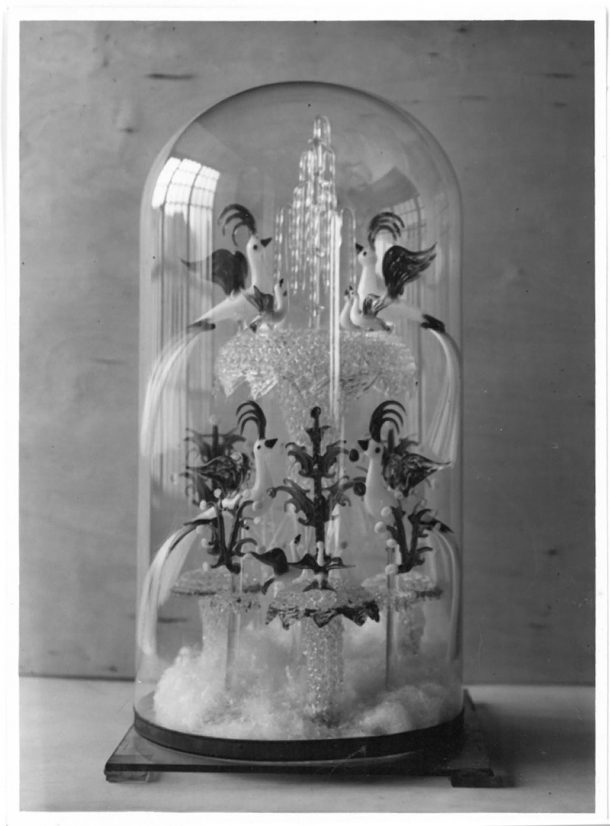
The centrepiece, donated to the Victoria and Albert Museum in 1936, is composed of seven lamp-worked glass parts. Lamp-work (also known as flame-work) uses a flame to soften prefabricated glass tubes and rods to create delicate objects. A range of colours and techniques were employed to create the fountains, the birds with spun glass tails, the delicate ship and the u2018seau2019 of glass fibres and flakes. The lamp-worked parts were adhered to a crudely cut, square plate glass base, which is surprising when compared to the craftsmanship of the lamp-worked parts. The dome has a thin velvet strip around its base and is held in place by four plate glass corners, the corners and velvet appear to have been added after the object was acquired (Figure 1). The base and corners are noticeably different in colour. X-ray fluorescence (XRF) analysis was used to compare the elemental compositions of the different types of glass, and the data can also be used to compare with other plate glass from the period.1
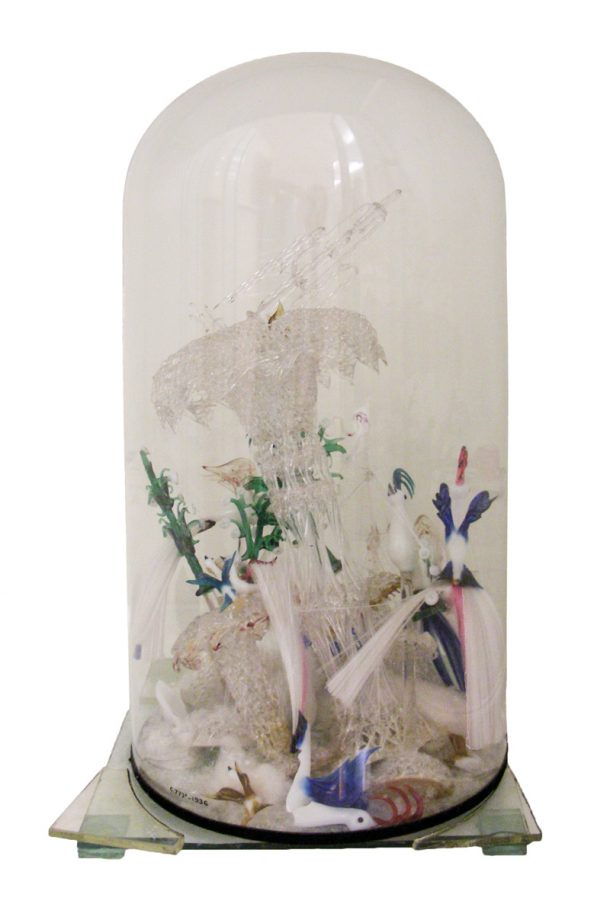
The object suffered damage in transit in 2003 (Figure 2). The fountain had collapsed inside the dome, the birds and small water spout had broken off the large fountain, and all the lamp-worked parts were no longer standing on their bases. Breaks had occurred across all parts, leaving 31 fragments loose inside the dome. The first challenge was removing the dome without the pieces collapsing further. A tube of Melinex (polyester film) was fitted around the lower two thirds of the dome and attached to the glass base with adhesive tape. The dome could then be lifted off, leaving the tube to support the fragments (Figure 3).
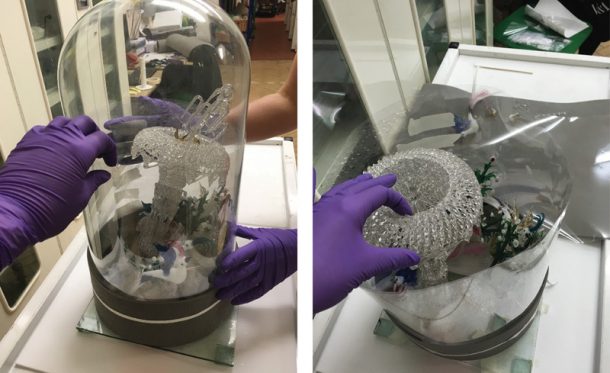
After the fragments had been removed, it appeared that many of the delicate components had escaped major structural damage. However, a large amount of adhesive that had been used to adhere the lamp-worked parts to the base obscured the full extent of the structural damage. Several different adhesives had been applied to the object in the past. In most areas the adhesive was pale yellow or brown and soluble in water, suggesting an animal protein glue. A thick, yellowed adhesive present at joins in the ship, the small fountains and where the small birds had been reattached to the front small fountain, was not soluble in water, acetone or industrial methylated spirits (IMS), suggesting it may be an aged epoxy or polyester resin.
During the removal of the thick adhesive at the base of each lamp-worked component, it quickly became clear that the bases were extensively cracked and broken, only remaining together due to the excessive amount of adhesive covering the original glass surface. The adhesive was slowly removed with a scalpel, softening areas with water where possible. Working in one small area at a time meant that the tiny glass fragments could be bonded back into position immediately with Paraloid B-72 (approximately 40% w/v solution in acetone). Paraloid B-72 (ethyl methacrylate methyl acrylate copolymer) was chosen for its long-term chemical stability and reversibility.
Some previous repairs were stable and not visually obtrusive, such as at the wings of several birds, so were left joined and noticeable areas of excess adhesive were removed. In other areas, fragments had been bonded in the wrong position. Where the previous joins were unstable or incorrectly positioned, the joins were dismantled, cleaned and bonded using Paraloid B-72.
Finding correct joins in the colourless lampworked glass was particularly challenging. The small fragments had several tiny points of contact and break edges were difficult to see in the colourless glass latticework, even with magnification. When the correct placement was found, it was just as difficult to hold the fragment in position for bonding. Bonding continued gradually until the delicate lamp-worked parts were ready to be reattached to the base (Figure 4). In areas where the Paraloid joins failed to hold or where extra strength was required, Hxtal NYL-1 (epoxy resin) was applied to the join. Once all the parts were securely attached to the base, the sea of glass fibres and flakes was reintroduced. Finally, the centrepiece was covered by the newly cleaned dome and the corners secured to the base with Paraloid B-72.
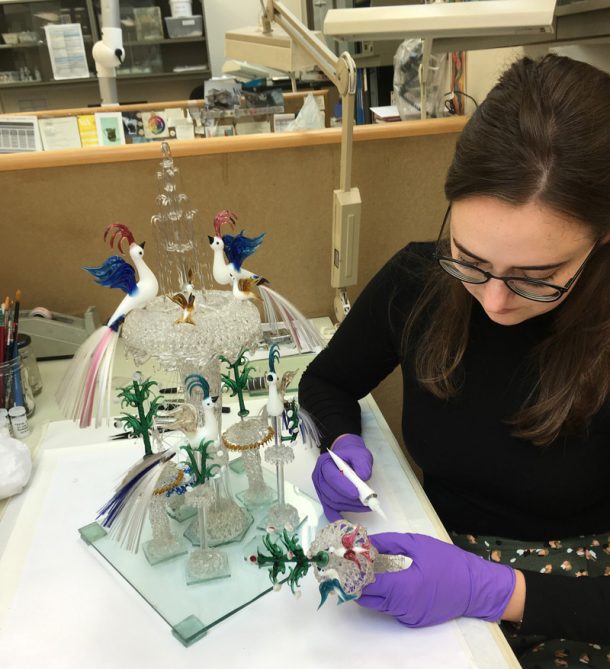
The treatment of the centrepiece was a practical challenge, requiring patience and a steady hand to relocate the fragments, but the more time that was spent working on the object the more enchanting it became. Now that the centrepiece is together once again it is ready for display in the Glass Galleries, where it can be enjoyed by all (Figure 5).
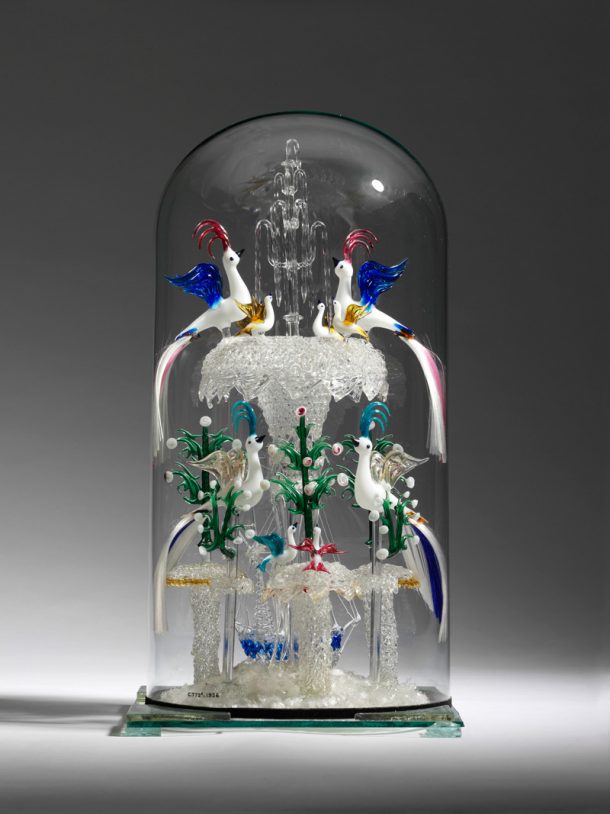
Acknowledgements
This conservation work has been made possible with funds raised in memory of Jonathan Nevitt.
I am grateful to my conservation colleagues, Fi Jordan and Victoria Oakley, for their advice, and to my curatorial colleagues, Reino Liefkes, Judith Crouch and Florence Tyler, for their expertise and assistance with this project.
References
- Manca, R, Burgio, L, Analysis Report 19-86-RM-LB Glass centre-piece u2013 C.772-1936, Victoria and Albert Museum, 2019.



I just Check your article and its really nice
My father owned an identical birds in a dome and it has exactly the same damage – my brother owns it. It’s great to see your one restored so well. I have just restored a glass ship also owned by my father – it rather sank in the powder glass in transit and then I had to remove a lot of dead flies which had climbed the rigging!